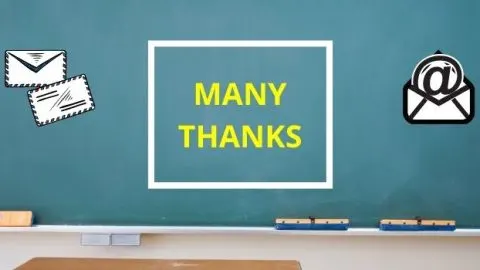These days, email is everywhere.
On the one hand, that means communication is faster and more efficient than it’s ever been before.
However, the ubiquity of email has given rise to a whole new set of phrases and words, along with rules on when and where to use them.
In this article, we’ll look at “many thanks” as a signoff phrase, and explore alternatives.
Is it okay to use “many thanks” at the end of an email?
The phrase “many thanks” is one common way to end emails, especially if you’re asking somebody to do something for you. Although some people think it’s not proper English, it’s a perfectly grammatical way to express your gratitude to somebody at the end of an email, letter or other written communication. If ending an email with “many thanks” seems like overkill, there are many possible alternatives.
Ending an email with “many thanks”
The phrase “many thanks” is just a way to say “thanks” when a simple “thank you” is not enough.
Where does this phrase come from? One possibility is German, where the expression “Vielen Dank!” (many thanks) is a common way of saying thank you.
It’s hard to say for certain, though, as many other languages also contain a similar or identical phrase.
Regardless of its origins, there’s nothing wrong with using “many thanks” to sign off after an email.
You probably shouldn’t use it for every single email you send, however, as it suggests that the person you’re writing to has either done something for you already or is likely to be doing something for you in the future.
Is “many thanks” proper grammar?
There’s some concern that “many thanks” is not correct grammar.
First of all, grammar is actually just a description of usage. That means the popularity of this phrase would make it a “correct” thing to say anyway, as long as people can understand it.
Digressions into the meaning of grammar aside, “many thanks” is perfectly grammatical no matter how you look at it.
The word “thanks” is the plural of the word “thank,” although the singular noun form has more or less vanished. “Thank” means something like “an expression of thankfulness,” so it makes sense for “thanks” to stand in for more than one.
With the plural form of a noun, you need to use the word “many” if you want to suggest there is a large quantity. So “many thanks” is more or less the same as “thank you very much.”
Examples
“Dear Robert,
I’m writing you this email because I need your help with the big presentation next week. Can you reply when you have time so I can fill you in on the details? It will be exciting!
Many thanks,
Sue”
Here, the author of the email is using “many thanks” because she is asking Robert to help her with something. In this case, in other words, the thanks are for a series of actions yet to happen.

Alternatives to “many thanks”
If you don’t want to sound too thankful, there are many other options you can use to sign your name on an email.
Thanks
Short, but sweet. It’s hard to go wrong with a simple “thanks.”
In a formal setting, the more polite “thank you” may be more appropriate.
Both show your gratitude toward the person you are writing without overemphasizing it.
Examples
“Mom, can you pick up my grades from the school? Thanks!”
This example shows that “thanks” works great in a text message, as well as in an email. Here, the assumption is that Mom probably won’t say no, and maybe that this isn’t a big task, so a simple “thanks” is more appropriate.
Let me know if you have any questions.
If you don’t want to take someone’s participation on a future project for granted, it can be useful to ask if they have questions about your email instead.
This way, you may increase your chances of a response to your email, and you will also get the recipient to think more about what you’re proposing.
Hopefully, that will make them more likely to participate when you answer their questions.
You can also combine this with a “thank you” if you want to be polite.
Examples
“Hi Jed,
Just writing a quick note to remind you that the harvest festival is next week, and we still haven’t received the money for your booth rental.
Let me know if you have any questions.
Ede”
Here, “let me know if you have any questions” is used to give the recipient a graceful way out of his lateness. This is a great example of how to use this phrase to elicit a response to your email.
3. Sincerely
Much like “thanks,” sincerely is a time-honored way to end a written communication in any medium.
It’s best suited to formal situations, or those where you aren’t very well acquainted with the person you’re writing to.
This option also works well if you aren’t actually thanking the recipient. If you do need to add some thanks, the formal “Thank you for your time” can be used.
Examples
“Dear Mr. Asimov,
Please find attached to this email a short story for your magazine, Asimov’s Science Fiction.
Thank you for your time and consideration.
Sincerely,
Steven Goulding”
A formal letter like the cover letter used when submitting a short story to a magazine for publication is a great place to use “sincerely.
There are many other suitable situations, as well.
I really appreciate your help.
In situations where you either need to be very formal or want to show how much you needed someone’s help with something, this is a great option.
As an added bonus, it can technically refer to both help already received and help you haven’t gotten yet, just like “many thanks.” However, if you want to be sure of getting help for something you haven’t done yet, you can write “I would really appreciate your help,” instead.
Examples
“Dear Mrs. Robinson,
I’m writing you on behalf of the whole team at Universal.
You have been an amazing person to have involved with this project, and we would be lost without you.
We all really appreciate your help.”
The context of this email makes it clear that this appreciation is being given for something that has already happened, so “would” is not appropriate.
This is a place where ending an email with “many thanks” would be a bit too casual.
Much thanks
Let’s backtrack a little on what we said earlier. If “thanks” is the plural of “thank,” it should use “many,” not “much.”
So what gives?
The truth is complicated, as matters of grammar often are. While “thanks” can be the plural form of “thank,” it can also be a type of noun called an uncountable, or mass noun.
Mass nouns are concepts and ideas that can’t really be split into discrete units.
The word “electricity” is a great example. You can’t say “I have two electricity,” because it isn’t that kind of concept. It needs to always be plural, and is thus “uncountable.”
“Thanks” as an uncountable noun means something like “feelings of gratitude” and takes “much” instead of “many,” so this is also technically grammatical.
That said, it’s less common than “many thanks,” and some people might think you made a mistake in typing it, so use this one with caution.

Hey fellow Linguaholics! It’s me, Marcel. I am the proud owner of linguaholic.com. Languages have always been my passion and I have studied Linguistics, Computational Linguistics and Sinology at the University of Zurich. It is my utmost pleasure to share with all of you guys what I know about languages and linguistics in general.

